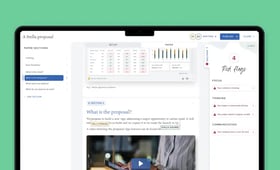This article is part of a series exploring the findings of our latest Board Report on stakeholder governance. You’ll find the entire series, including the research, at the end of this blog post.
In this blog, we aim to provide some helpful guidelines on how to identify the most telling stakeholder metrics and present them to your board in a way that drives insight, not frustration.
Key takeaways:
- Effective stakeholder reporting starts with asking strategic, stakeholder-focused questions and combining internal and external data to build trust and accountability.
- Boards often miss critical insights: 82% don’t track Glassdoor reviews and 40% don’t measure customer satisfaction.
- Identify the right metrics by focusing on the relationships most critical to your organization’s success and aligning them with organizational strategy and purpose.
- Balanced stakeholder dashboards integrate cultural, social, financial, and operational data into a clear, high-level organizational health view for board reporting.
- External data sources provide unbiased insights that validate internal reporting and strengthen credibility.
- Predictive stakeholder metrics help boards anticipate risks and opportunities earlier than financial metrics alone.
- Real-time monitoring captures emerging risks while annual reviews provide long-term perspective. Crises often demand more frequent tracking.
- Risk monitoring systems allow boards to spot early warning signals before they escalate.
- The successful implementation of stakeholder reporting requires modern dashboard technology, team training, and board education.
What is the foundation of effective stakeholder reporting?
Effective stakeholder reporting starts with asking the right strategic questions about culture, customers, and community, and using both internal and external data to answer these questions. By grounding reporting in stakeholder-focused questions, boards can better understand perceptions, build accountability, and strengthen long-term trust.
Why are 82% of boards not tracking key stakeholder metrics?
We were surprised to find in our research that 82% of boards don’t track Glassdoor reviews, despite these reviews offering a direct, unfiltered pulse of employees’ views and morale. This indicates that many boards undervalue the power of public perception. Your customers, future talent, and the wider community are looking at social media, review sites, and news sites to reach an opinion on you.
How you are perceived will reflect people’s willingness to trust you with their money, support, or career. Universities, for example, might look at externally reported league tables that present a range of metrics such as:
- Overall student satisfaction.
- Percentage of students who find employment six months after graduation.
- Percentage of first-year students continuing to the second year.
These are all powerful data points in determining success.
The sooner you take externally reported metrics really seriously, the better. See if any of the metrics you’re already tracking can be replaced with a metric monitored externally, or if you can supplement an internally reported metric with the findings from an externally reported one.
Starting with questions instead of data: A strategic approach
Your instinct might be to start by sifting through the data you’re already collecting to pull out a metric to track. But this is a sure way to get tangled in the weeds of stakeholder metrics. Instead, start with the questions you would like to answer.
What are 5 essential stakeholder questions that every board should answer?
What did you always want to understand about your stakeholders? What interesting questions were raised in conversations but couldn’t be answered?
Perhaps your board would love to know:
- Do we have a healthy culture?
- Why do our customers love our product?
- What is our environmental footprint?
- Do our suppliers like doing business with us?
- How well are we supporting our community?
Make a list of those questions and then see how data can help you answer them. Don’t avoid the important questions that are hard to measure. Just because you don’t currently measure something, or there isn’t an easy way to do it, doesn’t mean the question is any less worth answering.
How do you identify the right stakeholder metrics for your organization?
Identifying the right stakeholder metrics starts with clarifying which relationships are most critical to your success and what you most need to understand about them. The goal is not to track everything, but rather to focus on a key set of metrics that reflect stakeholder trust and align with organizational values.
Question-driven stakeholder metric selection
When choosing your question-driven stakeholder metrics, start with the critical questions your board or leadership team needs answered, instead of defaulting to whatever data is easiest to collect. You must ensure that the metrics you track provide insights that guide meaningful action. This will help you avoid data overload and focus on the signals that truly reflect stakeholder trust and value.
Cultural health assessment questions
- Do employees feel empowered to share ideas, challenge decisions, and raise concerns?
- How well do our stated values align with the actual day-to-day behaviors in the workplace?
- Are we fostering diversity, equity, and inclusion at all levels of the organization?
- What do employee engagement surveys, turnover rates, and retention trends reveal about our culture?
- How effectively do our leaders model and reinforce the culture we aspire to have?
Customer value and satisfaction indicators
- Are we consistently meeting (or exceeding) customer expectations for quality, service, and responsiveness?
- How does our customer feedback compare to competitors?
- Are customers seeing clear value in our products or services, and are they willing to recommend us?
- What recurring pain points or complaints reveal opportunities for improvement?
- How do customer loyalty and lifetime value align with our growth objectives?
Environmental impact and ESG metrics
- What is our carbon footprint, and how are we reducing it year over year?
- How responsibly are we managing waste, water, and energy use?
- Are we meeting (or exceeding) compliance standards for environmental regulations in all jurisdictions?
- How do we ensure transparency in reporting ESG performance to stakeholders?
- What long-term sustainability initiatives demonstrate our commitment beyond compliance?
Supplier relationship quality measures
- Do our suppliers meet agreed standards for quality, reliability, and ethical practices?
- How strong is the level of trust, collaboration, and communication with key suppliers?
- Are we managing risks (e.g., geopolitical, ethical, or operational) effectively across our supply chain?
- How diversified is our supplier base, and are we overly dependent on any single source?
- Are suppliers contributing to innovation, cost-effectiveness, and sustainability in our value chain?
Community engagement and social impact
- How are we investing in and supporting the communities where we operate?
- Do our initiatives align with community needs and create meaningful, measurable impact?
- How actively do our employees participate in volunteering or community-based programs?
- What partnerships (with NGOs, schools, or local organizations) strengthen our social impact?
- Are we transparent in communicating our community engagement outcomes to stakeholders?
Linking stakeholder metrics to business strategy and purpose
For many companies, the biggest stakeholder reporting challenge is the standalone nature of many metrics. A raft of 10 metrics across key and secondary stakeholders is interesting. But unless performance for the stakeholders is linked to your strategy or purpose, then those numbers will never be anything but nice.
“Ask yourself, ‘What is the opportunity to engage stakeholders to help us prosper?’ Companies that are doing well have the strongest narrative about their strategy.”
~ Founding Partner, Board Evaluation Firm
To ensure that all your stakeholders are reflected in your strategic planning, you must start by understanding their impact on your long-term and short-term success and your own impact on their well-being. With this reciprocal relationship in mind, think about where stakeholder interest and commercial impact meet for each stakeholder, then attach specific measures for value creation. More on how to link stakeholders to your strategy in our blog on how to embed stakeholders in your board’s decision-making.
Mapping stakeholder impact on short-term and long-term success
In the short term, stakeholders such as customers, employees, and suppliers affect day-to-day performance through sales, productivity, and operational continuity. Long-term success depends on how well the organization sustains trust with regulators, investors, and communities. Metrics for both the short- and long-term success of your organization must be mapped.
Building a balanced stakeholder dashboard for board reporting
By integrating stakeholder data with financial and operational measures, leaders gain a holistic view of performance that highlights drivers, risks, and opportunities. To maximize its effectiveness for board reporting, your stakeholder dashboard should focus on key strategic trends and tie each metric to actionable decisions, ensuring concise, data-driven insights that support accountability and trust.
Creating an organization health dashboard
This dashboard provides an at-a-glance view of your organization’s well-being, illustrated through data. Your stakeholder performance is vital to the prosperity of your organization, so stakeholder metrics belong side by side with metrics about your strategy, financial performance, and operational and governance information.
If you think of your board reporting as having a pyramid structure, then your organization's health dashboard is the apex of the pyramid. It contains the high-level message of the story you’re telling within a single page. Adding key stakeholder metrics to your dashboard allows you to see the performance of your stakeholders in the context of the organization’s health and allows you to identify risks and opportunities faster.
To create an organizational health dashboard, start by identifying the key metrics that reflect your company’s cultural, operational, financial, and social well-being. Ensure that the dashboard balances quantitative data with qualitative insights that capture context and trends. Present the information in a clear, visual format that helps leaders make data-driven decisions.
Integrating stakeholder metrics with financial and operational data
Integrating stakeholder metrics with financial and operational data provides a more holistic view of your organization’s performance. By aligning measures such as customer satisfaction, employee engagement, and community impact with revenue growth and cost efficiency, leaders can better understand the drivers behind financial outcomes. This integrated approach supports more balanced decision-making, strengthens accountability, and builds trust with key stakeholders.
What are dashboard design best practices for board presentation?
- Focus on key strategic metrics and trends, avoiding finer operational detail that can distract readers from making decisions.
- Use simple charts, clear labels, and consistent terminology so readers can easily interpret at a glance.
- Use visual cues like color coding or icons to highlight elements like progress and risks.
- Organize the dashboard in a way that guides readers logically from performance context to outcomes and implications.
- Group related metrics and use summary views to avoid overwhelming readers with details.
- Tie each metric to decisions, risks, or follow-up actions.
Sourcing external data for stakeholder insights
Data can be collected from publicly available reviews, social media, industry reports, and benchmarking studies to help your organization understand perceptions beyond internal metrics. This external perspective helps organizations gauge reputation, identify emerging risks, and compare performance against peers or industry standards.
Why are 82% of boards missing critical employee sentiment?
Glassdoor analytics typically include insights that help organizations understand employee sentiment, workplace culture, and employer brand perception.
Key elements often include:
- Overall company rating.
- CEO approval rating.
- Employee sentiment, including trends over time.
- Comparisons with competitors.
- Qualitative insights into strengths, weaknesses, and recurring issues.
- Recruitment brand metrics.
The 82% of boards that don’t track Glassdoor reviews are missing out on this crucial information.
Social media and review site monitoring for stakeholder perception
Monitoring social media and review sites provides real-time insights into how stakeholders perceive your brand, culture, and performance. Platforms like Twitter, LinkedIn, Glassdoor, and Trustpilot capture unfiltered feedback from employees, customers, and the wider community. This feedback often surfaces issues or trends before they appear in formal reports.
By monitoring sentiment, themes, and engagement levels, boards and executives can identify emerging risks, strengthen transparency, and respond proactively to concerns. This helps build trust by showing stakeholders that their voices are heard and acted upon.
External league tables and industry benchmarking
External league tables provide a standardized way to evaluate and benchmark performance, reputation, or outcomes against peers. This helps you get an objective view of your performance relative to your competitors, highlighting your strengths and areas for improvement. Incorporating these comparisons into stakeholder reporting helps boards understand competitive positioning, informs strategic decision-making, and demonstrates accountability to key stakeholders.
Replacing internal metrics with external validation
External data is important because it provides an unbiased, credible perspective on your organization’s performance that internal data alone may not capture. External benchmarks, such as customer reviews, industry rankings, or independent audits, help boards understand how stakeholders truly perceive the organization. By aligning internal decision-making with these external insights, your organization can build more trust with stakeholders.
Want early access to new features and research insights? Register for our newsletter to get notified before everyone else.
Be first to tryPredictive stakeholder metrics that drive future performance
It’s essential for boards to look at predictive metrics. Nearly all boards track revenue pipeline as one way to predict future performance. Within a stakeholder-driven market, your stakeholders’ perception of your organization can serve as a predictive indicator.
Why are 40% of boards not measuring customer satisfaction?
As we’ve mentioned, our research found that boards underestimate the power of perception. Instead, they focus on metrics directly related to financial performance, such as growth in customer spend and supplier on-time payments.
“Beating last year’s numbers is not the point; a performance measurement system needs to tell you whether the decisions you’re making now are going to help you in the coming months.”
~ Sir Andrew Likierman, London Business School professor
For each stakeholder group, ask yourself, “What could we track that could indicate potential risks and opportunities?” For example, measuring your customer sentiment through a simple metric such as net promoter score or customer satisfaction can give you an indication of whether you’re moving in the right direction. Similarly, public sentiment and employee engagement scores can be helpful in course-correcting your strategy to improve those relationships.
Surprisingly, 40% of boards don't measure customer satisfaction. This further highlights the boards’ lack of emphasis on public perception.
Net promoter score and customer sentiment tracking
NPS measures the likelihood that customers would recommend your organization, while sentiment tracking analyzes feedback from reviews, surveys, and social media to capture a variety of opinions. Together, these metrics provide actionable insights that help organizations enhance customer experience and address emerging issues before they escalate.
Employee engagement as a leading business indicator
Engaged employees directly influence operational performance because they are more productive, innovative, and committed to achieving organizational goals. Good engagement often correlates with lower turnover, better customer service, and stronger collaboration. By tracking engagement early, your organization can identify potential risks or opportunities in workforce performance and take measures to keep engagement levels high.
Public sentiment and reputation risk management
By tracking sentiment on social media, review sites, news coverage, and other public channels, your organization can identify emerging concerns or misinformation that could harm trust and undermine brand value. Proactively managing reputation helps safeguard stakeholder confidence, supports long-term relationships, and ensures that strategic decisions align with public expectations.
Stakeholder reporting frequency and monitoring strategies
There is no right answer for how frequently your board needs to monitor metrics about each one of your stakeholders. How often you look at stakeholder metrics will be determined by the nature of the question you’ve asked and the impact the stakeholder has on your organization.
Real-time vs. annual stakeholder metric reviews
A surprisingly high number of organizations feel that annual reviews of stakeholder groups are sufficient. 50% of boards look at metrics such as employee engagement only once a year and 29% look at public sentiment once a year. We believe this is insufficient, as problems in employee or public sentiment could emerge as major risks to the business in the meantime.
- Real-time stakeholder metric reviews allow leaders to spot shifts in sentiment or performance quickly and respond to risks before they escalate.
- Annual reviews can provide a broader, more reflective view that helps identify long-term trends and benchmark progress.
- Used together, real-time and annual monitoring approaches give boards the agility to act now and the perspective to plan for the future.
Crisis-driven frequency adjustments (COVID-19 case study)
In times of crisis, you will typically need to monitor stakeholder metrics more frequently. For example, if you are a retailer, you probably reviewed metrics relating to your suppliers at least weekly during the COVID-19 pandemic. For some key stakeholders, such as your customers and employees, there is information you need to have at your fingertips as it happens.
Hourly sentiment tracking UK building society success story
The UK Building Society has implemented a tracker to help them monitor sentiment on an hourly basis.
“We have a sentiment tracker (how are you feeling today?) on the intranet that’s monitored hourly, and the CEO has direct access to see whether sentiment is going up or down throughout the day.”
~ Company Secretary, UK Building Society
Stakeholder risk monitoring and early warning systems
Regular stakeholder risk monitoring helps organizations detect potential issues before they become major problems. These issues might include a drop in employee morale, customer dissatisfaction, or supplier instability. By proactively tracking leading indicators like reviews, engagement surveys, or compliance signals, boards and executives gain timely insights into emerging risks, effectively protecting their relationships and reputations.
Implementing stakeholder reporting in your organization
Implementing stakeholder reporting requires the right mix of tools, skills, and governance. Modern dashboard technology can consolidate data from multiple sources and help leaders identify risks and opportunities.
Teams require training in accurate data collection and analysis, as well as linking insights back to business goals and stakeholder trust. Meanwhile, boards must be educated on stakeholder governance principles so they can confidently oversee evolving expectations, regulatory requirements, and long-term value creation.
Stakeholder reporting technology and dashboard tools
Modern reporting platforms and dashboard tools make it easier to consolidate stakeholder data from multiple sources into a clear, real-time view. They allow boards to track trends, compare performance against benchmarks, and visualize the impact of stakeholder relationships on organizational success. Well-designed dashboards also highlight risks and opportunities, helping directors focus on what matters most.
Training teams on stakeholder metric collection and analysis
Giving your team the skills to collect, interpret, and report stakeholder data ensures accurate and meaningful metrics. Training should include how to connect data back to business goals and stakeholder trust. When teams are confident in their analytical skills, the organization gains richer insights and avoids misinterpretation of complex metrics.
Board education on stakeholder governance principles
Boards play a vital role in shaping how organizations engage with stakeholders, but this requires a strong grasp of stakeholder governance principles. Educating directors on best practices helps them oversee strategy with confidence and accountability. With this knowledge, boards are better positioned to balance financial goals with sustainable stakeholder value.
Read more:
- World Economic Forum — Measuring Stakeholder Capitalism: Towards Common Metrics and Consistent Reporting of Sustainable Value Creation
- Harvard Business Review — What Are Your KPIs Really Measuring?
- Harvard Business Review — Put Your Metrics Where Your Mouth Is
- Board Intelligence — The CEO Board Report in 90 Seconds
- Board Intelligence — Executive Summaries: The Secret to Better Board Meetings



